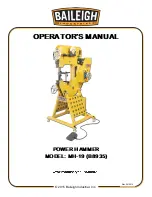
42
43
11 Storage
This chapter describes the most important information
forthe storage of the machine, its components and spare
parts.
Storage conditions
Always comply with the following storage conditions:
– Storage temperature: 15 to 25° C.
– Relative humidity: 40 to 60 %.
– Environment protected against UV light.
– Ozone-free environment (no fluorescent light sources,
mercury vapour lamps, photocopiers etc.).
– Store machine on pallets or shelves. Never store directly
on the ground or up against walls. This will help to pre-
vent the ingress of damp.
– Do not store directly beside heating units or other heat
sources to prevent material distortion.
– Store in a dust-free location (use dust cover).
– Do not remove corrosion inhibitor (e.g. oil film on untreat-
ed steel parts).
– As well as the storage conditions stipulated here, observe
the detailed instructions from the engine manufacturer.
– If a short or extended period of downtime is scheduled for
the machine, always take the necessary precautions to
maintain the functional capability of the machine.
Preparation for a short period of downtime
– Set the machine down in a stable and safe location.
– The fuel tank cap and the cap on the oil filler neck must
be sealed tightly to prevent these fluids from escaping.
Storage and preparation for an extended period of
downtime
– Set the machine down in a stable and safe location.
– The fuel tank cap and the cap on the oil filler neck must
be sealed tightly to prevent these fluids from escaping.
– Clean or replace the engine air filter.
– Protect the silencer on the engine to prevent the ingress
of foreign bodies.
– Spray the entire machine with a protective coating of oil.
– Store the machine under a roofed area that is ventilated,
dry and is not dusty. Alternatively, protect the machine
against prevailing weather conditions with plastic sheeting.
Recommissioning after an extended period of downtime
1. Clean the machine thoroughly.
2. Remove the guard from the engine silencer.
3. Check the fuel level.
4. Check the lubricant levels.
5. Start the engine and let it run for a few minutes.
6. Check the functional capability of the emergency and
safety equipment.
7. Check the effectiveness of the control elements and
displays (if provided) on the machine.
8. Carry out a function check at idle speed in all intended
operating modes and check the unit for abnormal vibra-
tions or noises.
Storage of plastic parts
Whenever chemicals, solvents, oils and greases come into
contact with plastics, they may turn the surface of these
plastics opaque, cause them to expand, decompose and
cause lasting changes to their mechanical properties.
For that reason, especially after an extended time in storage,
check the condition of plastic parts and replace them if
necessary, or contact the customer service
(see page 3)
of Goldschmidt Thermit Group.
12 Disposal
This chapter contains all the information required to dispose
of machine components and of lubricants and consumables.
All disposal of machine com-
ponents must be carried out by
trained specialists or by specialist
companies specifically hired to
perform this work. Always ensure
that disposal is environmentally
compatible.
Disposal of the machine
At the end of the life time of the machine, the owner must
arrange for the scrapping and disposal of the machine in
accordance with prevailing specifications, and conducted
by authorized disposal businesses. This applies to every
single machine component.
Furthermore, after every replacement of a machine compo-
nent that needs to be disposed of separately, the applicable
specifications must be observed, and authorized disposal
businesses must be employed.
Disposal of used oil
The disposal of used engine oil must be carried out in
accordance with regional, national and local legislation and
specifications.
The operator is responsible for correct classification of
waste products and this depends on the substances with
which the used oil may have been contaminated. If a compa-
ny does not possess an in-house disposal system for used oil,
a professional disposal company must be employed. Always
ensure that no oil is able to escape into the environment.
10 Spare and wearing parts
Only ever operate the machine with genuine spare and
wearing parts. A separate spare parts catalog of spare and
wearing parts is included in the scope of delivery. A list of
companies from which you can source spare and wearing
parts can be found
on page 3
.
EN
GLISH
DEUT
SC
H
TORQUE WRENCH WT 1400 P
OPERATING MANUAL
NOTE
















































